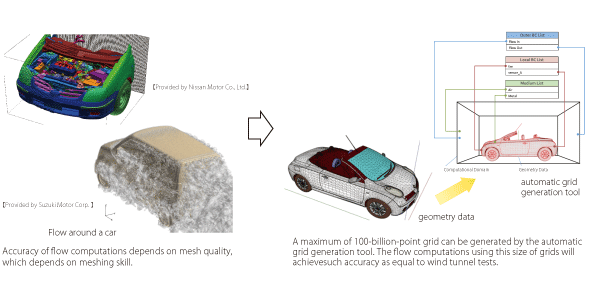Next-generation fluid-flow design systems based on direct computation of turbulence
- Theme Leader
- Chisachi Kato Professor and Center Director, Center for Research on Innovative Simulation Software,
Institute of Industrial Science, the University of Tokyo - Alliance for Research
- Kenji Ono Professor, Graduate School of System Informatics, Kobe University
- Makoto Tsubokura Associate Professor,Graduate School of Engineering, Hokkaido University
- Ryoichi Kurose Associate Professor, Graduate School of Engineering, Kyoto University
- Itsuhei Koori Professor, Graduate School Research Division in Engineering, Tokyo City University
- Akiyoshi Iida Professor, Graduate School of Engineering, Toyohashi University of Technology
- Takuji Nakashima Assistant Professor, Institute of Engineering, Hiroshima University
Research and Development to Accomplish the Strategic Goals
【Overview】
Targeting mainly turbomachinery, automobiles, and combustion and gasification equipment, we will research and develop next-generation fluid-flow design systems based on the direct simulation of turbulence. The objective is to have these systems used in actual design environments in industry, and to this end, we will establish a robust collaboration between government, industry, and academia. The developed systems will be laboratory tested and subjected to trials using actual equipment. In this work, we plan to contribute to Industrial Innovation by achieving a dramatic leap in prediction accuracy through ultra-large-scale analysis and to clarify the physical mechanisms of unsteady turbulence phenomena that are difficult to measure experimentally.
【Specific Research Targets】
1) Creation of design systems that include preprocessing and postprocessing for an HPC environment
Automatic mesh generation on a scale of several billion to several ten billion grid points will be made possible by adopting a hierarchical-refinement method of mesh generation based on an automatic-refinement function (refiner). In other words, designers who use the developed system will be able to set up interfaces to design systems that can automatically achieve ultra-large-scale analysis. These systems are expected to become practical within five years after the "K computer" becomes fully operational.
2) High-accuracy analysis of complex/composite turbulence phenomena
Achieving fluid-flow analysis that least depends on computational models will lead to high-accuracy predictions of complex and composite turbulence phenomena as in the three main coupled problems in automobiles (vehicle movement, heat damage, and cabin noise), vibration, noise and cavitation in turbomachinery, combustion and gasification characteristics in combustion/gasification equipment, and exhaust gas characteristics. Specifically, the goal is to achieve predictions as accurate as or more accurate than those achieved by existing wind tunnel tests, loop tests, and simple small models with regard to steady aerodynamic forces on vehicles, general performance and cavitation performance in turbomachinery, combustion/gasification efficiency, and concentration of exhaust gases such as NOx and soot.
3) Prediction of unsteady phenomena difficult to measure experimentally
The goal here is to predict unsteady phenomena that are difficult to measure experimentally with real equipment such as vehicle movement under wind gusts, flow-related vibration and noise in turbopumps, and flame ignition and accidental ignition in combustion chambers.
Software: FrontFlow/blue, VCAD/V-sphere, FrontFlow/red


